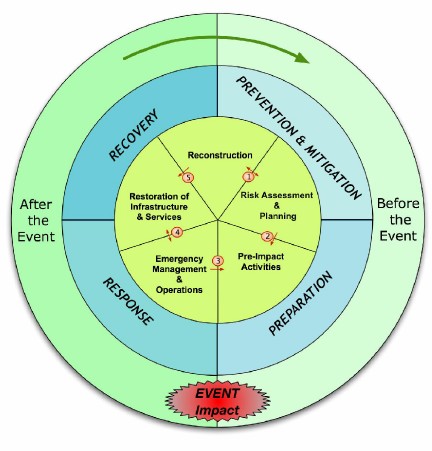WHAT IS DISASTER MANAGEMENT
INTRODUCTION
Disaster management simply means conservation of life and property during natural or man-made disaster. It refers to the organization and management of resources and responsibilities for dealing with all the humanitarian aspects of emergencies. There are four components of disaster management as suggested by International federation of Red Cross and Red Crescent societies.
- Preparedness- Simply means precautionary measures in the face of potential disasters. In fact preparedness is the main way to reduce the impact of disaster. This can be achieved through research and planning and particularly in predictable and vulnerable regions that is at risk of disaster. If we have precautionary measures and are being prepared along with risk reduction measures, definitely loss can be minimized.
- Relief and Response- The provision of emergency services and public assistance during or immediately after disaster. In all the natural disasters, rescue and relief operations could be more successful and effective if complete information about the extent of damage is gained.
- Recovery and Rehabilitation- Although, some response action may extend to recovery stage but recovery refers to those programmes which are beyond the provision or management of immediate relief to affected one. It includes the activities like rebuilding of infrastructure, health care and rehabilitation and other development activities. Besides, formulation of policies and practices are also important to avoid or mitigate the same events in future.
- Prevention– Prevention is better than cure, and hence advance action and activities to provide protection from the occurrence of disaster can prevent or avoid potential adverse impact on the life and property. So good risk management, elimination plans along with environmental planning and framework design can reduce the loss of life and property.

Presently disaster management is getting much attention and also involves programmes related to public awareness. In order to successful and effective rescue and relief operation, hot spots for a particular type of disaster are identified and information is collected about the past experience of disaster occurred, their extent of damage and other aspects. All these things assist to assess the frequency and intensity of disaster.
Read more..
WHAT IS DISASTER- MEANING & TYPES
ESSAY ON ENVIRONMENTAL POLLUTION
WHAT IS ECOLOGY- OVERVIEW & TYPES
RED DATA BOOK- OVERVIEW & CONSERVATION CATEGORY
ECOLOGICAL PYRAMID- DEFINITION & TYPES